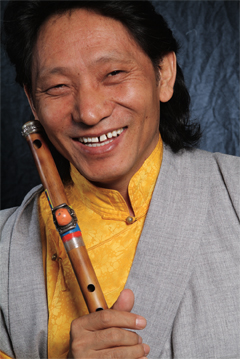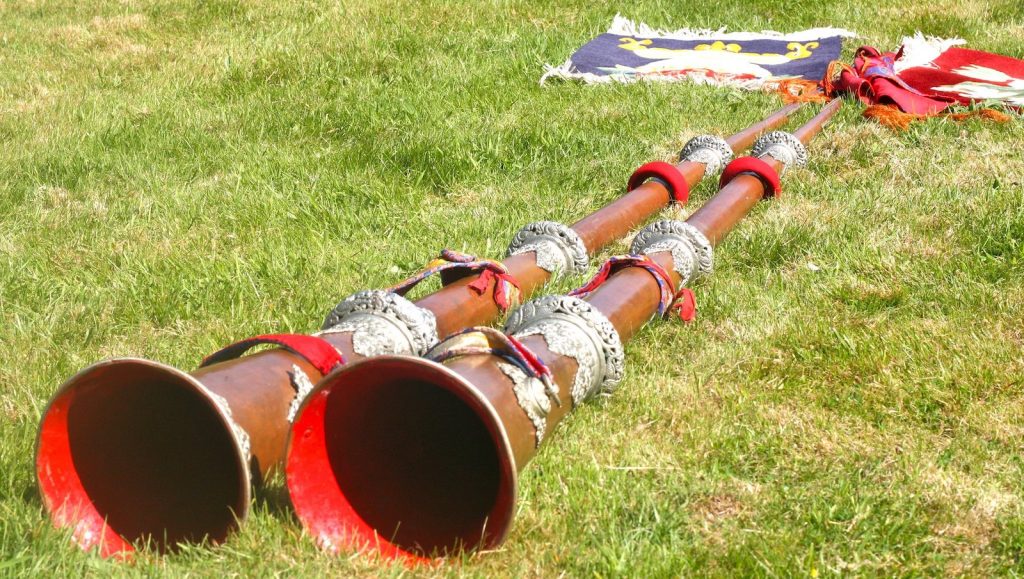Nawang Khechog is a musical sorcerer—a self-taught, Grammy-nominated star of meditation music who has sold three million albums worldwide (his latest CD, Tibetan Meditation Music, was No. 9 on the Billboard chart) and has collaborated with Kitaro, R. Carlos Nakai, Philip Glass, Paul Winter, Laurie Anderson, and David Bowie. Drawing on eleven years as a monk and mountain hermit, Khechog combines the fruits of long, deep practice with natural acoustic genius to create hauntingly beautiful compositions that mix earthy Tibetan chants with ethereal horns. (In addition to the flute, he has mastered the doongchen—Tibetan long horn—Aboriginal didgeridoo, African drums and kalimba, Mayan ocarina, and Native American drums.)
Born in Kham, in southeastern Tibet, Khechog fled to India at age six after the 1959 Chinese invasion. Nowadays, at 54, he occupies a singular place on the Buddhist scene as a teacher, performer, practitioner, and Tibetan freedom fighter. His many creative endeavors include a years-in-the-making documentary, due in 2010, about Tibetan hermit meditators; a workshop called “Awakening Kindness”; and even a newly invented video game, which he describes with the glee of a schoolboy. Having survived a near-fatal car wreck in India last year, the irrepressible artist is traveling less these days. (He and his wife live in Boulder, Colorado; he has two adult children from a previous marriage.) After a recent performance at Carnegie Hall in New York City, Khechog took time out to talk with Tricycle contributing editor Mark Matousek about his hybrid life, transformative sound, and near-miss with death—and how being a disobedient child gave him the surprising life he has today.
The path to where you are today—as a world-famous musician and meditation teacher—seems to have been paved with independence and stubbornness. For starters, you were a hugely precocious child. It’s true! When I was seven years old, shortly after we fled Tibet for India, I ran away to Dharamsala, to the Tibetan Children’s Village, a boarding school the Dalai Lama established for refugee children. It was run by his older sister, Tsering Dolma-la. Then, when I was thirteen, I begged my mother to let me become a monk. Three years after that, I ran away to join a Tibetan guerrilla group called the Special Frontier Force, or SFF.
You were a guerrilla soldier at sixteen? In fact, that’s where my real inspiration for the dharma came from—my time in the army. A fellow soldier told me about a great scripture, the Fifth Dalai Lama’s Lamrim Jamphel Shelung—“The Eloquent Teachings of Manjushri.” I borrowed it from a monk at the military temple and started reading it. Sometime later I found Patrul Rinpoche’s Kunzang Lama’i Shelung—“Words of My Perfect Teacher”—in Freedom News, a Tibetan-language newspaper that had a section on Buddha-dharma. Each week, they printed a part of the scripture. I used to wait for the paper and read it with great enthusiasm. These two teachings really shook my whole being. After that, all I wanted to do was become a hermit. The Dalai Lama gave me his blessing and sponsored me, offering personal guidance during the four years when I was a hermit in the mountains.
Why did you want to become a hermit? It’s a little bit like somebody who likes basketball and, instead of just playing the game here and there, decides to join a major league team and focus their whole life on becoming a great basketball player. You focus one hundred percent—body, mind, and spirit—on developing your spiritual qualities. You train for many hours every day, thinking that maybe you will one day become like Michael Jordan.
You wanted to be the Michael Jordan of the meditation world? Yeah, kind of. It was very difficult! You have to—how do you say?—reverse your nature. It’s like making water flow upstream. There was a time I almost never slept at night. I ate very simple food—just a small cake made out of dough and lentil. Eventually I developed tuberculosis and began to vomit blood. I didn’t take care of my physical body and became very sick. In the end, I spent years in and out of hospitals. When I meet new meditators, I always tell them to please be careful. Don’t forget to take care of your body! Physical health is just as important as spiritual.

After I got sick, I realized that even if I couldn’t go back up the mountain and be a hermit, my life was already different. Whether I’m in solitude or living in a town, I still can practice. The need to develop love and compassion is important wherever I live. The law of karma follows me wherever I go. So I decided to live in the world and keep practicing the Buddha’s teaching as much as possible in my day-to-day situation.
When did you realize that you were an artist? I was quite creative as a young boy, always the class clown. I taught myself to play the flute when I was in school and performed all the time. Being a monk and dharma practitioner helped me create my kind of spiritual music. I always meditate before I play or compose—clear my mind and heart. On the foundation of that clear, calm, focused state of mind, I then ask for blessings. Meditating on universal love, compassion, and responsibility, I then go onstage and play music with that kind of spirit.
You need to be in an elevated state of mind before offering transformative music to the audience? That’s it. It’s like rock and roll. You need to have that kind of energy—only then can you rock! Sometimes my music is highly energetic, like a piece I played last time at Carnegie Hall called “The Last Stand of the Wild Yaks.” It’s a very wild piece of music with drums and horns—an explosive energy release. When I perform such music, I need to tap into that energy. When I’m playing quiet meditative flute, I’m just totally calm and peaceful and relaxed.
How does being a musician affect your role as dharma teacher? First, I’m not a lama or guru or anything like that. I’m just a spiritual friend. I’ve been living in the West since 1985. I try to relate the Dharma to 21st-century human beings. As Einstein said, we human beings utilize only five to ten percent of our brain’s capacity. In the same way, we use only five to ten percent of our heart’s capacity to love and feel kindness. Instead of boxing in our hearts, loving only me, me, me—the smallest box—we must try to slowly expand that box till we’re able to love all humanity, all sentient beings. When we use our maximum intelligence to access these deeper levels, to go beyond the material, then we become wise. We realize interdependence and the transitory nature of existence—this is how we free ourselves from suffering. Then we can bring a lasting peace and happiness to the world.
Do you find that Western seekers have challenges that Eastern seekers don’t? Both challenges and strengths. Tibetans born in a Buddhist country are brought up from childhood to have faith in the dharma. But we don’t always study enough—investigate enough. We may go to temple and practice kindness, but we take it easy when it comes to deeper spiritual practice. Westerners, on the other hand, tend to work harder. They really investigate. They take the Buddha’s words to heart, when he said not to take his teachings on faith but to test them, to find out for themselves. Like a goldsmith, they cut and burn and rub the teachings to see if they are real.
If you put Western enthusiasm together with Eastern faith, you’d have the perfect Buddhist. That’s it! [laughs]
Tell me about your accident. I was in Nepal last February, receiving their highest civilian award. Afterward, I went to India, where my father lives, to celebrate the Tibetan New Year. My son and niece were in the car with me. Our driver collided with an oncoming truck. My niece, my sister’s daughter, was killed. I was unconscious, but my son was barely injured. He found a Red Cross medic who came and got me to surgery. My son saved my life. So did Richard Gere, who had me flown by charter plane from Orissa State to New Delhi. Because of my brain injury, they were not able to give me pain medication in the hospital. That is when my practice really saved me. I was going through agony, just lying there moaning. (I don’t remember this completely, but this is how my wife describes it.) After some time, I asked her to bring a pillow. I sat up and started to meditate. My wife and my son said that I meditated for forty minutes or so, and by the end, I became very peaceful and calm, totally without pain.
Your practice came to the rescue. I was doing tonglen, which is a particularly powerful practice. In tonglen, you take the suffering of all beings inside yourself—the suffering of the world—and pray for its relief. It’s as if the state of mind created by tonglen healed the pain. It brought a blessed feeling.
While I was recovering in Delhi Hospital, His Holiness called for me to visit him. After blessing me, he said, “Oh, you are the one who came back from the dead!” Then he said, “Can you play a flute?” And I said, “Yes, yes, Holiness, I am able to play a flute.” He said, “It is very important for you to travel around, play music, and represent Tibet.”
I’d like to hear about your video games—The “Journey to Wild Divine” series. The first one is called The Passage, the second is Wisdom Quest, and the third is Healing Rhythms. Dr. Deepak Chopra and Dr. Andrew Weil are also consultants on this series. The games incorporate biofeedback. People wear sensors while they play and can see their heartbeat on the computer. Then they have to meditate.
They’re interactive meditation video games? Exactly. You have to bring your heart rate to a certain level. If you can reach that calm state, then the game begins and you can take the journey. There are thousands of video games out there. Most of them are about violence, fighting, killing, all kinds of awful things. This is the first video game that helps people cultivate love and compassion. The idea is for people to be able to have fun and at the same time a spiritual experience.
So, you haven’t lost your precociousness? No! [laughs] Just think of it as an ex-monk’s new journey.
Thank you for subscribing to Tricycle! As a nonprofit, we depend on readers like you to keep Buddhist teachings and practices widely available.
